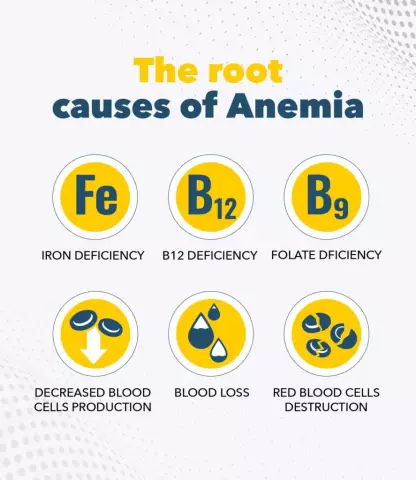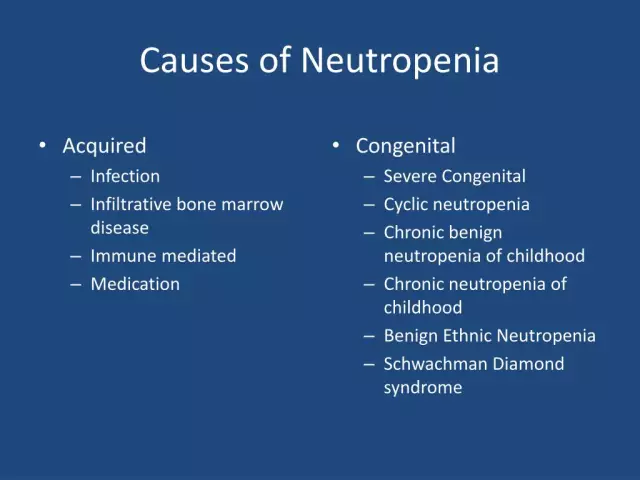- Author Rachel Wainwright [email protected].
- Public 2023-12-15 07:39.
- Last modified 2025-11-02 20:14.
Anisometropia
The content of the article:
- Causes and risk factors
- Forms of the disease
- Disease stages
- Symptoms
- Diagnostics
- Treatment
- Potential consequences and complications
- Forecast
- Prevention
Anisometropia is a violation of visual function, in which the refractive error index (a defect in the refraction of light rays) is different for each eyeball. For a full-fledged vision correction in this case, it is necessary to use lenses not of the same, but of different optical power.
The refractive power of human eyes is never the same. But they talk about the development of anisometropia only when the magnitude of the refractive error reaches 2 diopters or more, since this leads to the loss of binocular vision. As a result, it becomes difficult for the patient to correctly respond to external stimuli and navigate in space.

With anisomitropy, the refractive error reaches 2 diopters or more
Causes and risk factors
Anisometropia is usually congenital; its development is due to certain genetic defects. That is why this violation of visual function is most often observed in members of the same family.
Acquired anisometropia is very rarely diagnosed and develops in patients with cataracts, iridocyclitis, or as a complication after eye surgery.
Forms of the disease
There are several types of anisometropia:
- Axial. The length of the eye axes is different, but the refractive power of the optical apparatus of the eyes is the same.
- Refractive. The refractive power of the optical apparatus of each eye is different, and the length of the eye axis is the same.
- Mixed. Each eye of the patient has its own, different from the other eye, the power of refraction of light rays and the length of the eye axis.
Disease stages
Depending on the difference in refractive errors of each eye, anisometropia is of the following stages:
- Weak (up to 3 diopters).
- Medium (3 to 6 diopters).
- Strong (over 6 diopters).
Symptoms
With weak anisometropia, binocular vision practically does not suffer; a person may not be aware of the existence of a pathology.

Binocular vision impairment is the main symptom of anisometropia
If the difference in refractive errors between the right and left eyes exceeds 2-3 diopters, then in the visual analyzer of the brain, the pictures obtained from different eyes cannot merge into a single image, binocular vision is impaired. As a result, a person sees objects as indistinct and vague, his orientation in space is disturbed, headaches and nausea often occur.
Diagnostics
Anisometropia is diagnosed based on the results of the study of eye refractoriness (skiascopy, shadow test, retinoscopy).
Treatment
Conservative treatment of anisometropia consists in the selection of corrective contact lenses or glasses. This method provides good results, but it cannot be used with significant degrees of anisometropia.
If conservative therapy is ineffective, they resort to laser vision correction. The named method is highly effective and safe, the operation is practically painless, and the recovery period is only 10-14 days.

Laser vision correction is indicated for significant degrees of anisometropia
Potential consequences and complications
With a high degree of anisometropia, the visual analyzer cannot combine the images received from each eye into a single whole. The central nervous system seeks to protect itself from such discomfort by ignoring the resulting image from the eye with the greatest refractive error. As a result, the visual functions of this eye gradually fade away, amblyopia develops, or, as this condition is also called, the disease of the lazy eye. Another complication of anisometropia is converging or diverging strabismus.
Forecast
With timely treatment, anisometropia usually does not progress. Conservative or surgical correction can restore visual acuity and prevent the development of complications.
Prevention
There are no specific measures for the prevention of anisometropia. When the disease develops, it is important to treat it in a timely manner.
YouTube video related to the article:

Elena Minkina Doctor anesthesiologist-resuscitator About the author
Education: graduated from the Tashkent State Medical Institute, specializing in general medicine in 1991. Repeatedly passed refresher courses.
Work experience: anesthesiologist-resuscitator of the city maternity complex, resuscitator of the hemodialysis department.
The information is generalized and provided for informational purposes only. At the first sign of illness, see your doctor. Self-medication is hazardous to health!






